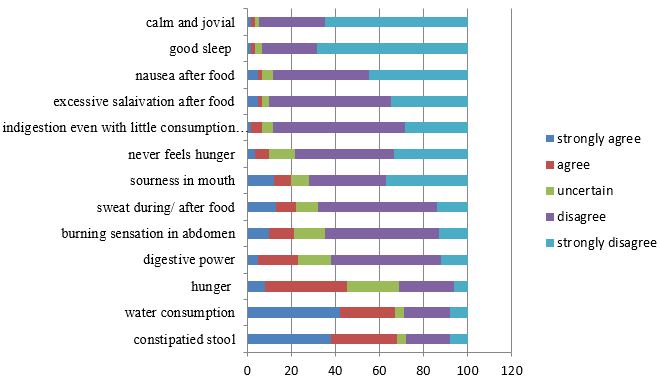An Observational Study on Agni Bala in Patients of Medo Dhatu Vruddhi (Sthoulya) w.s.r. to Obesity
DOI:
https://doi.org/10.21760/jaims.10.9.3Keywords:
Agni, Jatharagni, Vishamagni, Medo Dhatu Vriddhi, Sthoulya, Obesity, Ayurveda, Metabolic HealthAbstract
Introduction: In Ayurveda, Agni is regarded as the foundation of health, being responsible for all metabolic activities in the body. Among the various forms of Agni, Jatharagni is considered primary, as it governs and supports the functions of Bhootagni and Dhatvagni. This study focuses on the role of Agni, specifically Jatharagni, in the context of Medo Dhatu Vriddhi (obesity). Sthoulya (obesity), an increasing global health concern, is linked to the impairment of Agni, resulting in excess accumulation of Medas (fat tissue) and associated complications like hypertension, diabetes, infertility, and mental disorders.
Methodology: A cross-sectional study was conducted at Ashwini Ayurvedic Medical College and Research Centre, Tumkur, involving 100 volunteers (BMI >25), aged 20–60 years. A structured questionnaire was used to evaluate the type of Agni (Vishama, Teekshna, Manda, and Sama) and diagnose Medo Dhatu Vriddhi based on both Ayurvedic and modern parameters. The responses were statistically analyzed to explore correlations between Agni status and obesity.
Results: Results showed that 58% of participants exhibited Vishamagni, 30% Teekshnagni, 10% Mandagni, and only 2% had Samagni. A significant correlation was observed between Vishamagni and higher BMI levels, suggesting a key pathogenic role in Medo Dhatu Vriddhi. Lifestyle factors such as sedentary occupations and junk food consumption were prevalent, contributing to Agni imbalance.
Discussion: This study highlights the central role of Agni - especially Vishamagni - in the manifestation of Sthoulya. Correction of impaired Agni should be the first step in the Ayurvedic management of obesity. These findings reaffirm the classical Ayurvedic concept that the regulation of Agni is essential for maintaining metabolic balance and preventing lifestyle disorders.
Downloads
References
Acharya JT. Charaka Samhita with Ayurveda Dipika commentary of Chakrapani Datta. Reprint ed. Varanasi: Chaukambha Orientalia; 2011. p. 513–514.
Acharya JT. Charaka Samhita with Ayurveda Dipika commentary of Chakrapani Datta. Reprint ed. Varanasi: Chaukambha Orientalia; 2011. p. 513.
Sharma PV. Bhela Samhita with English translation. 1st ed. Varanasi: Chaukhambha Visvabharati; 2000. p. 367, 369.
Sushruta. Sushruta Samhita. Sutrasthana, Chapter 15, Shloka 37. Edited by Shastri AD. 12th ed. Varanasi: Chaukhambha Sanskrit Sansthan; p. 62.
Vaghbhatta. Ashtanga Hridayam. Sutrasthana, Chapter 14, Shloka 1–37. Edited by Upadhyaya Y. Reprint ed. Varanasi: Chaukhambha Sanskrit Sansthan; 2005. p. 100–103.
Chakrapanidatta. Charaka Samhita. Sutrasthana, Chapter 21, Shloka 20. Edited by Acharya YT. Reprint ed. Varanasi: Chaukhambha Surbharti Prakashan; 2005. p. 117.
Dalhanacharya S. Sushruta Samhita. Sutrasthana, Chapter 15, Shloka 38. Edited by Acharya YT. Reprint ed. Varanasi: Chaukhambha Orientalia; 2002. p. 73.
Arundutta. Ashtanga Hridaya. Sutrasthana, Chapter 14, Shloka 33. Edited by Paradakara HSS. Reprint ed. Varanasi: Chaukhambha Subharati Prakashan; 1997. p. 227.
Dwarakanath C. Digestion and Metabolism in Ayurveda. 2nd ed. Varanasi: Chaukhambha Sanskrit Series; 1997. p. 64.
Acharya YT, editor. Sushruta Samhita of Sushruta with Nibandha Sangraha commentary by Dalhanacharya and Nyayachandrika Panjika by Gayadasacharya on Nidanasthana. Varanasi: Chaukhambha Sanskrit Sansthan; 2010. Sutrasthana, Chapter 35, Shloka 24. p. 154.

Published
How to Cite
Issue
Section
License
Copyright (c) 2025 Rohit H.E., Rakesh H.R., Nija Chacko, Padmanabha Rugvedi

This work is licensed under a Creative Commons Attribution 4.0 International License.














